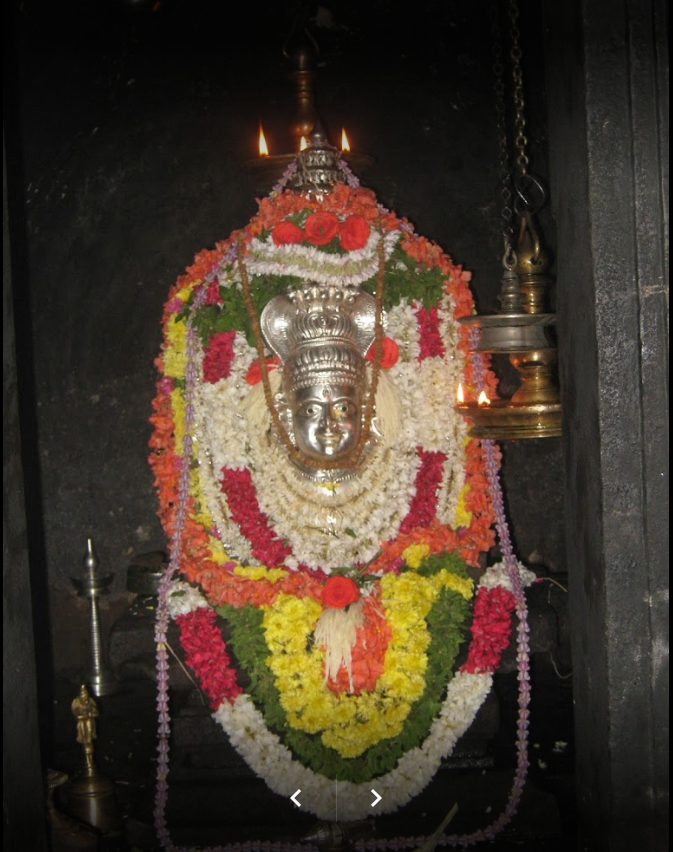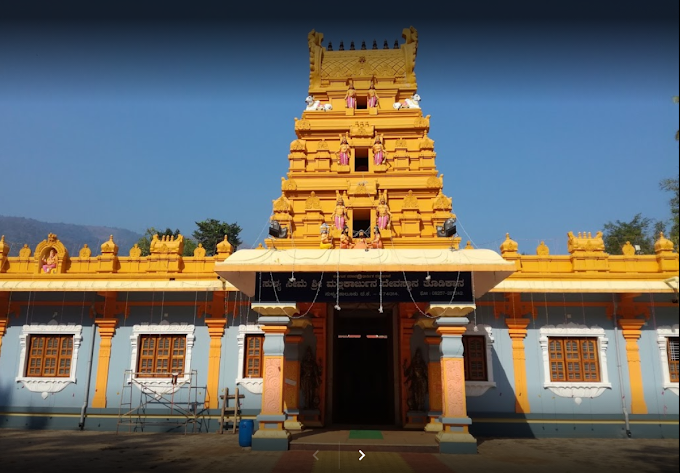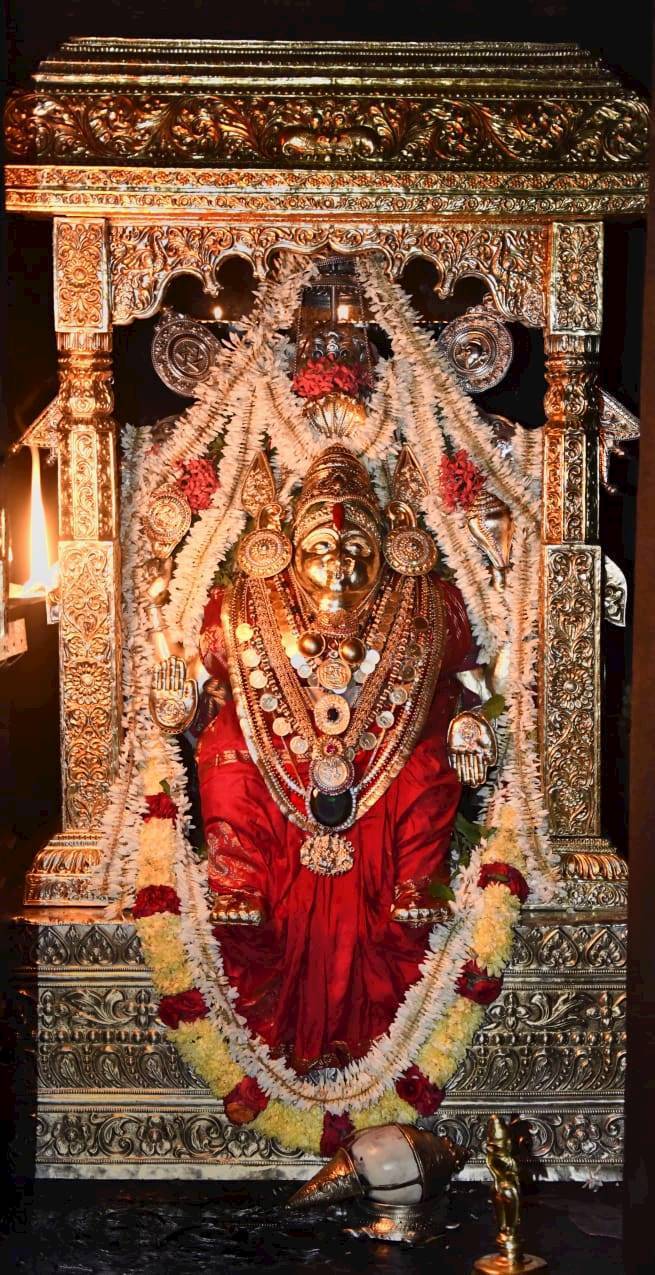About
The main deity of the temple is Sri Somanatheshwara (Shiva). The temple also has MahaGanapati and Jabali Maharshi as deities here. In fact, the Jabali Maharshi Brindavana was recently constructed. In typical Tulu-naadu tradition, the temple also has its set of “Bhootas“. Bhootas are considered as the “Ganas” or warrior-assistants of the Gods. The main bhootas of the Nellitheertha temple are Pili-Chamundi (Pili means Tiger in Tulu), Kshetrapala, Raktheshwari and Doomavathy.
The Lingam of Shri Somanatheshwara has been made out of pure Saligrama shila and is considered very sacred. There are other artifacts in and around the temple which are pointers to the past glory of this place. Among them are the “Arasule Mancha” (King’s seat), “Arasule Mantapa” (King’s abode) and the “Jina Vigraha” (Jain Statue). The temple of Shri Mahaganapati has been rebuilt recently and is splendid in itself.
The most beautiful aspect of the temple is the Cave, which is described in the subsequent section. The “Nagappa Kere” is a small pond situated to the north of the temple. This natural pond, along with its religious significance, is also a scenic spot. The lake is at its best immediately after the monsoons (Oct—Dec) when its crystal clear water is a swimmer’s delight.
The “Arasule Mancha” or King’s seat is situated near the main entrance of the temple towards the north. Historical evidence suggests that this seat was where the king of the land used to be seated when he visited the temple. It is believed that even today, the spirits of the former rulers visits the place at night and so it is prohibited to sit on the seat after dusk.
The Nellitheertha temple is a symbol of secularism. The temple and the cave is open to members of all beliefs and castes. Any person, above the age of 5, is allowed to enter the cave irrespective of gender. Truly, Nellitheertha is a special and model place.
The Cave
The main attraction of the temple is the cave. Situated right at the entrance of the temple towards the left of the main door, this huge cave is one of nature’s wonders. Un-spoilt by human indulgence, the cave is a nature lover’s delight. A visit to the inside of the cave is considered a sacred and spiritual experience by devotees. The entrance to the cave is huge and wide. Within a few feet, the trail narrows down and one is forced to bend and crawl forward. Subsequently, one has to fall flat on the tummy and crawl ahead. Finally, after about 300-400 metres, the cave widens again and we find a huge lake in there. There is a natural Shiva Lingam in front of the lake and devotees pray and worship the lingam. The most amazing part of the cave is the fine quality of the mud available inside. It is said that the mud here has healing powers and is treated as prasadam by devotees. Right behind the Shiva Lingam, a second cave starts off. Not many people have ventured into this second cave till date. A few who have gone ahead vouch for the extreme terrain they have encountered. It surely will be challenging for the adventure lovers.
The name Nellitheertha also has its etymological roots in the cave. Inside of the cave, drops of water, in the shape of amla (gooseberries) constantly keep dripping down. In fact, the lake is made up of these drops of water. Hence the name Nelli (Amla) Theertha (holy water). Another unique aspect of the cave is that it is closed for nearly 6 months a year. The cave is open only between October and April. Though there are religious reasons associated with this (it is said that the cave is open 6 months a year for humans and is meant for Gods and Rishis the remaining 6 months), the point is that the 6 month break each year helps the cave to “rejuvenate”. The water freshens up and the animals inside enjoy the lack of disturbance.
The holy place Nellitheertha and the temple have a long and glorious history. Although the first recorded material mentioning Nellitheertha dates back to 1487 A.D, there is ample evidence available at the place to suggest that the temple existed much before that. At its glorious peak, there used to be daily festivities performed under the aegis of the ruler of Nellitheertha. From that grand state, the temple gradually declined and its existence itself was threatened towards the later part of the twentieth century. Since then, devotees and well wishers have got together to restore the temple to its previous grandeur. With the blessings of Shri Somanatha, the temple renovation work is now on in full swing.
Historically, the Nellitheertha region was under the administration of the Chowta family. The chowtas are a famous name in Tulu Naadu and it is said that the temple flourished under their administration and was a major center for religious and cultural activities under their reign. Even today, the descendants of the chowta clan take an active interest in the maintenance and development of the temple.
There are some artifacts and archeological evidence available at the temple which point to a Jain interest and influence at the temple. These are evidence to suggest that the temple and the region was probably under the administration of Jain kings of the region.
Jaatre:
Every year, around the last week of December, the Nellitheertha temple conducts its annual Jaatre (festival). This is a grand five day event full of religious and cultural ceremonies. The festival starts on the 14th day of the Shukla Paksha in Dhanur Maasa. Typically, this falls on the last week of December or the first week of January. The festival begins with a silver flag being hoisted to indicate the beginning of the Jaatre. This is called “Kodi” or “Dhwajaarohana” ceremony.
Each of the four days has separate ceremonies like the “Balis” where the idol of the presiding deity is carried around the temple for a procession accompanied by music, the”Rudrabhishekas” where the Shiva Lingam is given a grand shower with 101 vessels of water and the “Rathotsava” where the deity is taken on a procession on the chariot.
The climax of the festival is on the fourth day. Called the “Aarat” in local language, the ceremonies on this day mark the end of the festival. During the day, the presiding deity is taken on a procession in the Ratha or the chariot. Villagers offer their prayers during the procession. There is also an event called as the Pilchandi Bheti (meeting of Pili-Chamundi with the Lord) where the Bhoota offers its prayers to the Lord during the procession and seeks his blessings and vows to carry on the role of protecting Dharma in the region. The rituals are followed by a grand lunch for one and all.
The rest of the ceremonies start late in the evening and goes on till dawn next day. The deity is taken on a procession and villagers offer “Katte Pooje” to the deity as it passes their residence. The deity is taken to the temple pond and “Avabhrutha Snana” happens. Finally, the flag is brought down to indicate the closure of the festival.
Contact
Sri Kshetra Nellitheertha
Neerude Post, Kompadavu Village
Mangalore Taluk, South Kanara District
Karnataka, India – 570063
Phone : 91-824-2299142
Email: contact@nellitheertha.com















